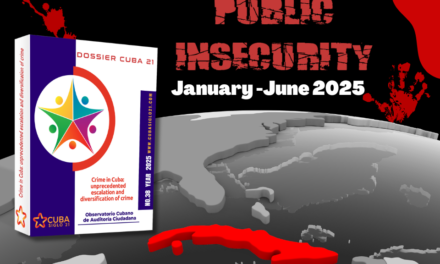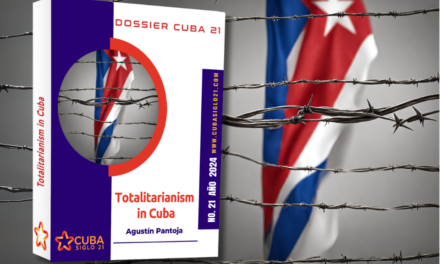Descargar informe completo en pdf
Download Report in English pdf
The Report on Public Insecurity in Cuba 2023 provides a detailed overview of the increase in crime on the island during the year 2023. This report is based on a thorough monitoring system of complaints, notes and statements published in social networks and both state and independent media, with the aim of verifying and triangulating the information obtained.
Context and Methodology
The report stresses that the crisis in Cuba has fostered not only an increase in the crime rate, but also a culture of criminality. This phenomenon is linked to several factors, among them, the change in social and cultural values, where respect for legality has drastically decreased, and the influence of criminal subcultures has grown, glorifying the criminal life.
Despite the lack of previous reports, it can be affirmed that 2023 was the year in which crime began to be recognized as a problem in Cuba. As part of its own monitoring, OCAC counted 649 crime reports over the twelve months, almost two crimes per day.
Throughout 2023, OCAC monitored and collected a total of 649 crime reports in Cuba, which equates to nearly two crimes per day. These reports include a wide range of crimes, such as robberies, murders, assaults and assaults, with a notable concentration of violent crimes in the months of July and June, which were the most violent months of the year.
Main Findings
The report presents an alarming picture of the security situation in Cuba. Of the 649 reports registered:
- 265 were thefts.
- 197 were related to murders, two of them double murders, bringing the death toll to 199.
- 124 referred to assaults.
- 33 addressed aggressions.
- 30 were classified as “other”.
In keeping with the fact that it is the most populated province in the country, Havana was the place where most crimes of different classifications occurred during the year: 90 robberies, 45 murders, 58 assaults, 15 assaults and 9 of other types, for a total of 217 incidences. Both in robberies and crimes of other types, Villa Clara is in second place, with 55 of the former and 7 of the latter.
The province with the second highest number of murders, after Havana, was Guantanamo, with 18, closely followed by Santiago de Cuba and Granma, with 16 each, and Matanzas, with 14. In terms of assaults, Holguin is in second place, with 18, followed by Villa Clara, with 14.
It is important to note that the authorities were able to solve 58.78% of the reported cases, although this figure varies according to the type of crime. For example, 69.57% of murders were solved, but only 47.46% of assaults, reflecting a disparity in the effectiveness of law enforcement in different areas.
In terms of the composition of identified criminals, the report notes that the vast majority of offenders were men (558), compared to only 19 women. In addition, crimes committed both individually and in groups were identified, with solitary crimes being more frequent.
Victimology
The victims of these crimes were diverse. During the year, 443 people were victims of crimes in Cuba, 237 of whom were men, 152 women, 20 elderly and 34 minors. Of these, 199 were killed as a result of criminal violence: 87 men, 86 women, 17 minors and 9 elderly.
In addition, 271 people were recorded as having suffered some form of violence, fatal or otherwise, including 152 men, 80 women, 24 children and 15 elderly.
Contributing Factors
The report identifies several factors that have contributed to the increase in crime in Cuba:
- Changes in social and cultural values: Respect for legality has diminished, and criminal subcultures have gained influence, promoting violence as a way to resolve conflicts.
- Decapitalization and deprofessionalization of the police: The lack of resources and adequate training for the police forces, together with their subordination to the political police to repress dissent, has reduced the effectiveness of crime prevention and control.
- Perception of impunity and corruption: The perception of impunity within the judicial and police systems has encouraged criminality, as criminals are confident in their ability to co-opt judges and police officers.
Conclusions
The report concludes that in order to contain and reduce the increase in crime in Cuba, it is essential to recognize the seriousness of the problem and address the underlying structural causes. This can only be achieved with a comprehensive change in the current model of society, radically transforming the country’s economic, social and political structures. The document warns that without decisive action, crime will continue to rise, further eroding security and social cohesion in Cuba.
This annual balance underscores the urgent need for profound reforms in the country’s justice and security system, as well as a change in the government’s approach to crime. Only through a comprehensive approach and real political will can we hope to have a lasting impact on the containment and reduction of crime in Cuba.







